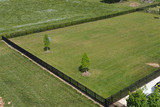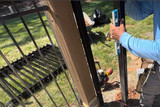Preparing to Install a Fence This Spring: A Step-by-Step Guide
Spring is the perfect time to install a fence. The weather is warming up, the ground is thawing, and your yard is ready for an upgrade. Whether you're looking for privacy, security, or simply a new aesthetic for your property, preparing properly will ensure a smooth installation process. Here’s what you need to know before getting started.
1. Plan Your Fence Design
Before you break ground, determine the purpose of your fence. Are you looking for a decorative accent, security, or a way to keep pets and children safe? Once you’ve identified your goals, choose a fencing material that suits your needs, whether it’s wood, vinyl, aluminum, or chain link.
2. Check Local Regulations and HOA Rules
Many municipalities have zoning laws and building codes that dictate fence height, style, and placement. If you live in a neighborhood with a homeowners association (HOA), you may have additional restrictions. Check with your local authorities and HOA before purchasing materials to avoid any compliance issues.
3. Measure and Mark Your Property
Accurate measurements are key to purchasing the right amount of fencing materials. Use a measuring tape and stakes to mark where the fence will go. Also, verify your property lines to ensure that you’re not encroaching on a neighbor’s land. If necessary, hire a surveyor to confirm the boundaries.
Read More: blog/how-to-measure-and-plan-for-a-yard-fence
4. Call Before You Dig
Utility lines often run underground, and hitting one can be dangerous and costly. Call 811, the national "Call Before You Dig" service, to have utility companies mark any underground lines before you start digging post holes.
5. Gather the Necessary Tools and Materials
Depending on your chosen fence type, you’ll need specific tools and materials. Common tools include a post-hole digger, level, hammer, and drill. Make sure you have all necessary components like posts, panels, nails, screws, and concrete for setting posts.
For Installation Videos:/gerneral-faqs/
6. Prepare the Ground
Spring often brings wet soil, which can make digging more manageable. However, excessive moisture can lead to shifting posts. Ensure the ground is dry enough to provide a stable foundation. You may need to remove rocks, roots, or other obstructions before starting the installation.
7. Install Posts Correctly
Fence posts provide the framework for your fence, so their installation is critical. Dig post holes to the recommended depth (usually about one-third of the post length) and fill them with concrete for stability. Use a level to ensure they are straight before the concrete sets.
8. Attach Panels or Rails
Once your posts are secure, attach fence panels, rails, or pickets, depending on your fence style. Ensure they are evenly spaced and properly aligned. If using wood, consider treating or staining it for durability and weather resistance.
9. Perform a Final Inspection
Walk along your fence line to check for any weak spots, misaligned sections, or loose fasteners. Make adjustments as needed to ensure everything is secure and level.
10. Maintain Your Fence
To keep your fence looking great and functioning well, perform regular maintenance. For wooden fences, apply sealant or paint to protect against moisture. Metal fences may require rust prevention treatments, while vinyl fences can be cleaned with soap and water.
Ready to Get Started?
Installing a fence in the spring can enhance your property’s value and functionality. With proper planning and preparation, your new fence will stand strong for years to come. Happy fencing!
Recent Posts
-
Experience, Reputation, Customer Service
Here’s why buying from OnlineFenceStore.com is a strong choice for fencing products: Key Advantages …Aug 13th 2025 -
How to Order Fence from OnlineFenceStore.com: A Step-by-Step Guide
How to Order Fence from OnlineFenceStore.com: A Step-by-Step Guide Ordering a fence online has never …Jul 30th 2025 -
Plumb vs. Level: Understanding the Difference in Fence Post Installation
When it comes to installing a fence, getting the job done right the first time is crucial. One of th …Jun 19th 2025







